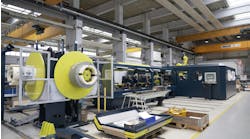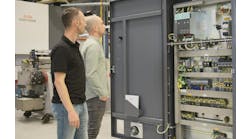When sitting down to write this, the subject matter drew me back to one of my earlier projects, an e-book describing the whole path from inspiration to commissioned automation project. It is interesting to realize how much has changed in my designs over the short eight years that I have been with my current employer but the fundamentals remain unchanged to this day.
After years serving primarily as a PLC programmer, my then new job with a co-packer pushed me in a direction I was somewhat out of practice with—that of control design. I realized, early on, that I benefitted greatly from the fine work of some great control designers, and it was from their work that I based my first designs with my new company. Some of those designers are readers of this column and to them I give a tip of the hat and a huge thank-you for sending me off into this world with a great set of design tools and practices that I continue to use over and over again to this day.
An automation project always starts from the same base point. Whether it is a water desalination plant or leak tester for the automotive industry, the project is born from a need to perform a task. Over the years, I have learned that the most important part of any project is taking the time to learn all the facts up front. Many a project has been launched from excited inspiration only to be dragged down quickly by a lack of good forethought. Essential to this part of the process is questions. There must always be questions, and the more, the better. Gather all the essential stakeholders together and don’t be afraid to lay it all out on the table, even at this early juncture. Rely on your experience, and feel free to share your experiences on similar projects as this can prompt a healthy discourse on what should be included and omitted from the finished product.
Another early consideration is the size of the project—physically. For instance, a packaging machine might only have a 10-ft-by-20-ft footprint, whereas an assembly line might be hundreds of feet long, and a water-treatment plant could cover acres of land. The approach to the control design depends much on the reach of the items that need to be controlled. An automotive leak tester might fit comfortably into a 6-ft-by-6-ft area. For this small size, direct wiring from the main control panel to the control devices might be the easiest to design and implement. A cartoning machine is generally larger—the previous example with the control panel and furthest controlled device being 20 ft away. In this case, a main control panel with machine-mounted I/O would be a better approach as it cuts down on the long wire runs. A packaging line or an assembly line or automated warehouse management system can have elements that are hundreds of feet away from the central control panel and, in this case, the use of satellite, or remote, control panels combined with machine-mounted I/O would make the most sense.
A decision on the power and control voltages would be a great next step. There is nothing worse than assuming that a certain power supply will be available only to find out, after the expensive hardware components have been purchased, that the 240-V system needs to be 480 V. The major power and control components tend to be expensive, and another reason to determine the correct voltages is to make sure that plenty of lead time is available to purchase and receive the components. Having said what I just did, care must be taken to make sure that the choice of controller is the right one.
Regardless of the brand of PLC or PAC, there are many options available based on the number of I/O points and networks involved. One way I make sure I have the right choices in place is to open up the design software and assemble the proposed system in the hardware architecture prior to actually placing an order for the components. This important step has saved me from suffering the wrath of an angry purchasing agent on more than one occasion. With today’s smart devices, it is even more important to not only build the controller design in the software, but also to make sure that your chosen controller can talk to all the higher function devices such as variable-frequency drives (VFDs) and servo drives. For instance, one controller might allow for four expansion I/O modules and eight common-industrial-protocol (CIP) devices, which are called different names by different automation providers but the basic premise is to connect like devices on a common network protocol, such as Ethernet I/P. Perhaps your design only needs three I/O modules and five CIP devices at the outset, but the need to add more I/O or devices nearer to the completion of the project might put your initial choice in jeopardy. A gut check using the application development software can be well worth the effort.
Any control design must have one major consideration that requires particular attention to make sure it is right. The safety of the people that will operate your creation is paramount, and the backbone of that consideration is the safety relay. Safety relays have come a long way since I first started in this business more than 30 years ago. Great strides forward have happened in just the past two or three years, and those advances have been to the distinct advantage of the designer. A nice side effect of these technical improvements has been a reduction in the number of components required to make up a safety circuit. All safety devices are dual-channel and most major automation providers have a wiring system that makes connecting the various components that make up the safety circuit easy to implement.
Devices such as servo drives and variable frequency drives now contain safe-torque-off technology that incorporates a means of electrically isolating the power input from the outputs of the drive, using the output channel from the safety relay to enable/disable the circuit. The latest iterations of these safety relays even have monitoring modules that reside on the Ethernet I/P network of the controller and communicate with the individual safety relays using fiberoptic links across the back plane of the modules. To the programmer, the access to not only the open/closed state of individual safety devices—door switch, e-stop button, safety mat—but diagnostics on each device, as well.
No matter how detailed the design is, the panel build is the most important part of the project. I have learned over the years that I am only as good as my electrician. I have had the honor of working with many great electricians over the years, but I have to say that my current partner in crime is the best I have ever encountered. There are many skilled individuals out there, but to find one that can work with the designer on such an intellectual level is a rare find and a joy to experience. This all might sound smarmy or contrite, but the connection I have with my electrician truly makes us a design team and the best of both of us goes into every system we produce. We often liken it to a good marriage, where we complete the other’s thoughts and often resume conversations on a different day like they were a simple continuation of the previous sentence.
The welcome benefit of the relationship I have with my design partner is I am keenly interested in learning new techniques and products to make his panel build as easy as possible. The safety wiring system I mentioned earlier is just one example of how the build can be improved with the use of new technology. Our larger projects include new guarding packages on packaging equipment and the elimination of individual wiring to safety devices with the use of a network of safety devices with the incorporation of what I would compare to IO-Link where status, temperature, margins and other information is available for any individual device through a four-wire connection system. This is one way I make the job easier for my panel builder. Another vital piece of the puzzle is the modern proliferation of panel wiring devices. Some might say that terminals are just terminals, but the effective use of multi-level terminals to reduce panel footprint is a welcome change to the panel build. The use of safe-torque-off technology has significantly reduced the panel footprint by eliminating the need to have safety contactors before or after a drive.
Finally, the focus by automation providers over the past year or so on integrated software solutions has enhanced the design/build process. One demonstration I recently attended showed the development of newer human-machine interface (HMI) products that cut down on the amount of screen navigation programming by including a configurable navigation bar as a standard screen item. Another intriguing feature was the incorporation of add-on graphics (AOG). Much in the way that add-on-instructions work for PLC programming, the AOG is a user-designed graphic element that can be loaded into an HMI design and assigned to a matching tag structure in the PLC. Some vendor-designed add-on graphics are available with more planned as the product gains development time. These same operator-interface devices allow for any PLC tag to be identified as an alarm point with HMI assigned upper/lower limits, rather than specific programming in the PLC to generate a graphical representation of the alarm condition in the HMI.
As with any other aspect of a control design, a library of designs is an essential part of the process and greatly streamlines the design/build process. We have even gotten to the point where we can verbally discuss the need for a control panel and, due to the refined design in a previous project, we have been able to begin the panel build before the design ever makes it to paper. The bottom line is: Go with what works. Standard design elements mean common familiarity, and we use that to great advantage in things such as common wire numbers. Our designs always have unswitched and switched control wires with the same wire number use from panel to panel. We even stretch that out to use with machine cables where Wire 1 is always 24V, Wire 2 is 24S (for switched), Wire 3 is always the 0V, and so on.
The techniques described here have allowed our team to pump out control panels at a rate that might surprise many OEMs since we are actually end users of automation. We have done complete control upgrades to full-sized cartoning equipment in as little as three working days. It all comes down to planning well, asking lots of questions and including extra room for the late-term changes that always come with an automation project. Mistakes will happen, but learn from those mistakes and don’t be afraid to try something new as it might save you time the next time you have a need.






